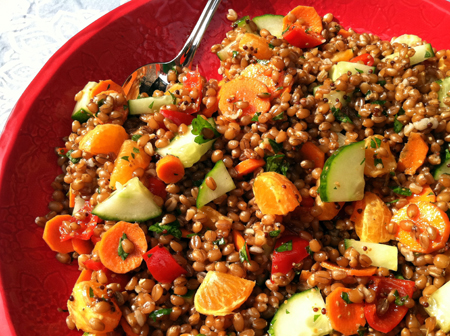
You know how sometimes, when you finally meet an idol, you totally screw it up? You don’t? Oh. Well then you’ll really get a kick out of this story.
Two weeks ago I attended the launch event for Kat Flinn’s new book, The Kitchen Counter Cooking School—I wrote about it here. You may recall I mentioned meeting Maggy, Pam Anderson’s daughter, and how I’m a huge fan of Pam’s older cookbooks, one in particular: How to Cook Without a Book: Recipes and Techniques Every Cook Should Know by Heart. While writing Parents Need to Eat Too that book was always nearby—I used it as a touchstone, an encyclopedia of flavors, an inspiration.
If you were paying close attention, you noticed that, while I recounted how Maggy rescued me after she saw my tweet-plea for a friendly face, I didn’t mention meeting Pam herself. Instead I watched her from my wallflower station (not like a stalker, I swear), noticing how many people seemed to know her—which they should, since she’s written six previous cookbooks, one of which won the Julia Child Award, with two others nominated for a James Beard Award and yet another nominated for an IACP Award. Oh, and she’s also a New York Times bestselling cookbook author, which is no small feat.
So yeah, Pam’s a supahstar.
And when she came over to where Maggy and I were gabbing, Maggy introduced me. I started gushing like a deranged fan, explaining in one rambling sentence how I used to work at Doubleday and ohmygod I loved working on her book, it’s one of my top-ten favorite cookbooks of all time, seriously The New Doubleday Cookbook has a place of honor on my shelf, I prefer it to The Joy of Cooking, blah blah blah…
She and Maggy smiled and nodded, and Pam thanked me graciously. They left my company soon after.
I didn’t realize my mistake until the panel started and Kat Flinn introduced Pam: The New Doubleday Cookbook (which, yes, is amazing, and is in my top ten) was written by JEAN Anderson, not Pam. I’d raved about the wrong book. How to Cook without a Book, the book PAM wrote, was indeed published while I was working at Doubleday, but it was published by Broadway Books, at the time a sister company. I’d just met one of my culinary heroes and made a complete fool of myself. I was beyond embarrassed. As soon as the panel ended, I jumped over to where Maggy sat and asked her to convey my apologies to her mother—I was too flustered to face her myself. Pshaw, Maggy said. She and Pam had been scratching their heads about my comment, but Pam wasn’t offended at all.
And wonder of wonder, miracle of miracles, Maggy was right. Pam came over soon after, I babbled something about how mortified I was, and she laughed and gave me a huge hug. Not only that, when I emailed the next day to ask if I could write about her new book—a meatless companion to How to Cook without a Book, the very book I’d intended to rave about, my wish was granted.
Cook without a Book: Meatless Meals is, like the first book, a collection of formulas more than recipes, though there are quite a few specific recipes included. It’s a reading-cookbook, a jumping-off point for using whatever you’ve got on-hand. So if you feel like making, say, a creamy roasted vegetable soup, Pam gives you a master formula: a couple pounds of roasting vegetables (which you choose from a provided list), olive oil, onion and garlic, the spice blend of your choice (also from a provided list), and so on. Follow the basic instructions, use what you’ve got, and there’s dinner. Perfect for parents, no? Sometimes consulting a recipe again and again is just too challenging, what with the baby crying and the “I can do it myself” preschooler spilling milk all over the table. Using formulas, precision is not an issue.
Divided into two parts, one devoted to breakfast-all-day approaches, and the other to more traditional categories like soups and stews, sandwiches, and (my favorite) pie for dinner, it’s intended not just for vegetarians but for all of us who are eating less meat these days. I don’t do a whole lot with the notion of “Meatless Monday,” mostly because in my kitchen the balance is the opposite—it’s noteworthy when we do have meat. The rest of the time we’re vegetarian, largely because, like Pam, I’m concerned with where my meat comes from. I prefer to buy just a little bit of organic chicken or a steak from the fancy artisanal butcher, rather than larger quantities of (considerably less expensive) factory-farmed food. No surprise, I was sold on this book as soon as I heard the title.
The first formula I tried, for a grain salad (halved, to serve 2), was a huge success: I tossed 2 cups of wheat berries (my fave) with 1 1/2 cups of chopped vegetables (carrot, cucumber, and—going off-list here—clementines). From the “extras” category, I chopped 1/4 cup of peppadew peppers for a spicy-sweet burst. Added some finely chopped shallot and a couple tablespoons of chopped mint and parsley, and tossed it all together with half a batch of Pam’s Lemon-Mustard Vinaigrette (1/2 a medium clove garlic, minced, 1 tablespoon lemon juice, 1 tablespoon Dijon mustard, 1/1 tablespoon rice vinegar, salt & pepper, and 1/4 cup extra-virgin olive oil). A friend and I feasted on the result, a simple, satisfying, healthy-but-not-austere lunch packed with bright, clean flavors.
I think I’m over my embarrassment now. And Pam, if you’d like to confuse me with somebody next time we meet, go right ahead.

